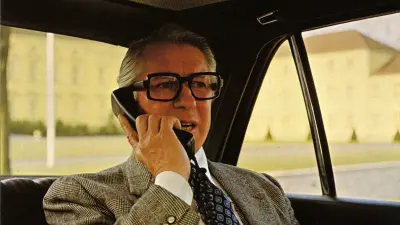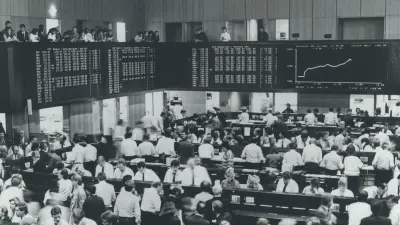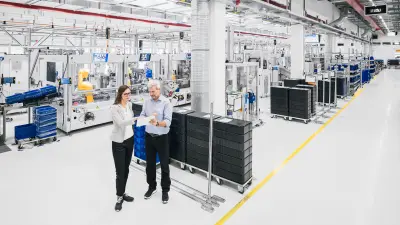History of Bosch Building Technologies
From emergency calls to connected buildings

What does a fire detector have in common with a camera along the rim of an active volcano? What does a taxicab dispatch center have to do with the world’s longest sea bridge? And what does the optimization of business processes have to do with the sound from the loudspeakers at World Cup stadiums in South Africa? The answer is: Bosch Building Technologies — a relatively new division, but one with roots that go back 100 years. Unlike other segments at the company, security technology at Bosch did not develop from a single core area of activity following a straight course. It is a competence area rooted in audio and video transmission, telecommunications, and alarm monitoring technology, all of which have been covered by a wide range of different operating units at Bosch in past decades.
Hanseatic roots
Bosch’s security technology got its start in northern Germany. Hanseatische Notruf AG was founded in 1920. The company developed alarm monitoring technology and acted as a police emergency call center in Hamburg. Meanwhile, in southern Germany, Bosch — today the parent company — was busy launching a host of innovations that made cars suitable for everyday use and paved the way for their success, such as magneto ignition devices (including spark plugs), as well as a vehicle electrical system with a generator and a battery for lights and an electric starter. Horns, direction indicators, and windshield wipers followed later. Still, the paths of the automotive supplier and the emergency call system company would not cross for years to come, as the product portfolios were both literally and figuratively miles apart.
In 1935, Frankfurt-based Telefonbau und Normalzeit GmbH took over Hanseatische Notruf AG. The move formed an initial connection to the security technology segment in Stuttgart, since Bosch would gradually acquire a majority stake in Telenorma — as the telephone maker later came to be known — starting in 1981.

Wide-ranging experience in communications technology

The precursors
Looking back, it becomes clear that Bosch had already developed various key competence areas for building technology prior to that, as diversification had long since opened up new technologies beyond the automotive business. For example, Bosch’s pioneering achievements in video and audio transmission initiated the creation of expertise that is still of importance for the video technology of today. From 1929 onward, Bosch and its partners worked to make television recording technology ready for production. Three years later, engineers from Stuttgart developed Europe’s first car radio. Since 1954, Bosch has produced two-way radios, with car phones joining the mix in the 1980ies. In the end, the company’s experience in communications engineering benefited its building technology.
Bosch Telecom and Communication Centers

As part of the gradual takeover of Telenorma and ANT, a manufacturer of communication systems for public networks and the aerospace sector, Bosch forged all of these activities into the Telecommunications business sector in 1989. Telecommunications was on equal footing with the three already-established business sectors: Automotive Technology, Industrial Technology, and Consumer Goods and Building Technology (known then as Thermotechnology and Power Tools). The main business fields of this new business sector, which would be renamed Bosch Telecom just a short time later, were telephones and telephone systems, private and public networks, and aerospace technology. Mobile communications, consisting of car radios, navigation systems, and mobile phones, also played a role. Another part of the business sector was a business unit by the name of Security Systems that focused on building security — the predecessor to today’s Bosch Building Technologies.
While Bosch Telecom initially developed positively, at times accounting for some 25 percent of Bosch’s total sales, the business prospects deteriorated in the second half of the 1990s. However, the security business remained unaffected. During that time, it launched some major new products, such as the UEZ universal emergency-call and fire-alarm center and the ViStar video-recording and surveillance system.
In addition, the service business for processing emergency calls and fault messages from stationary objects such as buildings, elevators or industrial plants grew. This began in 1985 with the establishment of two security control centers in Cologne and Frankfurt.
This was the beginning of Bosch Communication Centers, from which the current Bosch Service Solutions GmbH division emerged in 2016. It is dedicated to the development of innovative, technology-driven service solutions. The topic of emergency calls still plays an important role here. For example, more than ten automobile manufacturers in 56 countries now successfully use the Bosch eCall service.

The birth of the Building Technologies division
Although Bosch would gradually divest and spin off its communications technology activities after 2000, the security systems business would remain a successful part of the company. However, it needed to be reorganized. In 2002, the Security Systems division — today known as Bosch Building Technologies — was born.
The division took a targeted approach to expanding its area of expertise. Before 2000, the business activities of Bosch Security Systems were focused primarily on the facilities business in Germany. Since then, it has come a long way — both organically and through acquisitions.
In particular, company acquisitions have served to strengthen expertise in specific business fields and to expand the product range offered by the segment for security and communications systems. The most important acquisitions include Detections Systems (2001), Philips Communication Security & Imaging (2002), Video Communication Systems AG (2004), ADC Technologies International (2005), TeleAlarm Group, and Telex Communications (2006), as well as Extreme CCTV (2008). Today, the Bosch Building Technologies division is among the major suppliers in the international product business, above all in the industry’s fastest-growing segment – video technology.
Integration and building solutions
With the acquisition of Climatec in 2015, Bosch strengthened its business with customized solutions for building automation, security technology, and energy efficiency. This set a solid foundation going forward, offering tailormade solutions and services on a global scale. It was therefore only logical that the division was renamed Bosch Building Technologies in 2018 — as a result of visionary decisions, pioneering inventions, and up-to-date intelligent networking.

Focus on systems integration and fire alarm systems
In 2019, Bosch Building Technologies expanded its capabilities by acquiring GFR - Gesellschaft für Regelungstechnik und Energieeinsparung mbH, a renowned German specialist in building automation. GFR's comprehensive range of hardware, software, and services makes it a valuable addition to Bosch Building Technologies’ offerings. In 2021, Bosch further bolstered its fire systems portfolio and enhanced its presence in the European market through the acquisition of the British company Protec Fire and Security Group Ltd. The acquisition of Hoerburger AG in 2022, a German firm known for its extensive range of products and solutions in building automation and energy management, allowed Bosch to strengthen its offerings in energy services, and building automation.
In 2023, Bosch took another significant step in expanding its system integration and fire business in North America by acquiring Paladin Technologies, Inc., a leading provider of security and life safety solutions, and West Coast Fire & Integration Inc.The acquisition of DMS Digitale Mess- und Steuersysteme AG in 2024 further reinforced Bosch's commitment to the growing field of building automation.
With the sale of Bosch Building Technologies' product business for security and communications technology to Triton in 2024 , the company clearly emphasizes its strategic focus on systems integration and fire safety solutions.
Author: Dietrich Kuhlgatz


